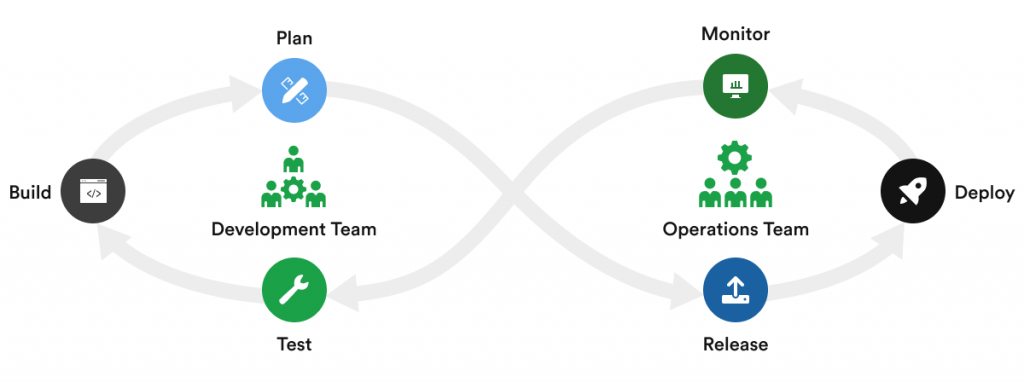
DevOps Outsourcing Best Practices in 2023
DevOps outsourcing, like any significant business decision, has challenges and risks. This article explores DevOps outsourcing best practices in 2023.
There’s no turnkey approach to building a successful DevOps team. This is because every software development team will have its own unique requirements.
However, through our extensive experience working in DevOps teams, we can provide some tried and tested tips.
But first…
DevOps is essentially a combination of philosophy, best practices, and tools that enable close cross-team collaboration that is measured for improvement throughout the software development lifecycle.
DevOps started life as a shared responsibility model leveraged by both developers and operators. However, it has since evolved to include business (BizDevOps) and security (DevSecOps) teams.
The primary objective is to eliminate siloes and enhance collaboration. Furthermore, developers and operations teams can seamlessly build and support their software products by taking shared ownership over continuous software improvement.
Although this tip sounds straightforward, anyone working in recruitment will tell you that it’s far from it. Finding the right people in a highly competitive labor market is no easy task.
Companies hoping to attract and hire the best DevOps engineers must offer a lucrative remuneration package and benefits to attract them. Once you hire top tech talent, you also have to make a considerable effort to keep them (from jumping ship).
In this scenario, it’s best to let your long-term vision drive the project and your DevOps team. Instead of focusing on building a highly specialized team, concentrate on building a team with experts and well-rounded generalists.
It’s important because you have to maintain speed throughout each iteration. You will also need to team members who can jump back and forth between the backend and the frontend.
Team structure plays a critical role in delivering successful DevOps projects. The team structure is actually more important than who is in the DevOps team.
In this case, it’s best to avoid traditional hierarchies and organizational charts. Adopt software development best practices like continuous integration and continuous delivery (CI/CD). If development and operations teams work in siloed environments, sustaining a collaborative multi-modal IT environment will be challenging.
So, make sure that both the development and operations teams collaborate closely and take responsibility for release cycles, version controls, and production environments.
Is there an ideal DevOps team structure? No. Every DevOps team is unique, and companies must explore what worked and what didn’t for other businesses of a similar size and sector. It’s best to compare the pros and cons of the DevOps models used by each organization before committing. You can also leverage Conway’s Law to build the perfect DevOps team structure.

Smaller DevOps teams tend to perform better. This is why Amazon introduced the concept of two-pizza teams. According to the tech conglomerate, the most effective DevOps teams will be small enough for everyone to eat two slices of pizza.
Smaller teams are also closer and able to adhere to the loosely coupled, microservices style model. However, reorganizing existing teams into smaller groups can be a daunting task. As such, it’s best to build out portfolio-based teams across the organization.
A portfolio-based DevOps team will be functionally or role-aligned and share the same leadership. The leadership will be close to everyone involved with the development process. This approach helps build and mature the organization’s ability to quickly deliver value to its customers.
DevOps teams are usually the first to try out new tools and methodologies. However, getting this wrong will have a considerable impact on deliveries. So, it’s important to invest time and resources to choose the right innovative tools that will get the job done and create a lot of excitement.
This approach can also go a long way to help staff become more effective and improve engineer and team retention. Take time to identify the right tools and train your team to get the most out of the latest cutting-edge technologies.
DevOps teams need mentors. New recruits will want to know that they are working with highly skilled team members (especially the ones they report to) who will help them grow. If you don’t have any leaders within the organization that can mentor your engineers, it’s best to hire some.
Strong DevOps leaders make great teachers. They are at the forefront of DevOps communities and engage in unique research projects. As candidates look up these individuals, it’ll be a great way to attract top tech talent.
If you already have some DevOps leaders within the organization, encourage them to build their personal brands. Get the word out and get them to engage the community at large to attract and retain top DevOps team members.
As the labor market is highly competitive, financial incentives and related benefits alone won’t help you attract and retain top DevOps talent. By allowing the DevOps team to work autonomously, your company stands a better chance of attracting top talent that can work effectively in a DevOps environment.
When autonomous DevOps teams take total ownership of projects, they also tend to get more curious and engaged around user experience or how the customer uses their product. This approach helps drive better outcomes with every problem they solve.
Most organizations have now eased into distributed working environments. Those who haven’t been able to will have difficulty developing new methods of engagement with colleagues. If you fall under this category, invest time and resources to identify the best communication options.
The key here is not to create new processes. The best approach here is to streamline established procedures based on good development best practices. For example, you can automate functions like checking on code commits.
By creating a robust and autonomous DevOps culture, organizations will benefit from team members making their own decisions. They will also benefit from this trust and organizational efficiency.
Although building a highly effective DevOps team is challenging, it’s not impossible. Just focus on people and their skills, not the latest tools and technologies. Through trial and error, your organization will find the right balance that makes DevOps teams highly efficient and effective.

DevOps outsourcing, like any significant business decision, has challenges and risks. This article explores DevOps outsourcing best practices in 2023.

This article shares top six strategies that prove to be effective when it comes to cloud cost optimization.

This article explores six trends that are driving DevSecOps evolution and affecting its adoption among technology teams and companies in 2022.
Copyright © 2023 rinf.tech. All Rights Reserved.
Terms & Conditions. Cookie Policy. Privacy Policy.
Politica Avertizari de Integritate (RO)